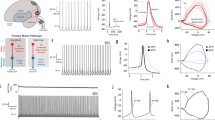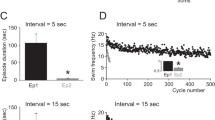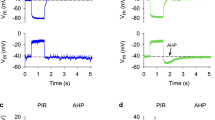Abstract
Objective
Motor control is encoded by neuronal activity. Small conductance Ca2+-activated K+ channels (SK channels) maintain the regularity and precision of firing by contributing to the afterhyperpolarization (AHP) of the action potential in mammals. However, it is not clear how SK channels regulate the output of the vocal motor system in songbirds. The premotor robust nucleus of the arcopallium (RA) in the zebra finch is responsible for the output of song information. The temporal pattern of spike bursts in RA projection neurons is associated with the timing of the acoustic features of birdsong.
Methods
The firing properties of RA projection neurons were analyzed using patch clamp wholecell and cell-attached recording techniques.
Results
SK channel blockade by apamin decreased the AHP amplitude and increased the evoked firing rate in RA projection neurons. It also caused reductions in the regularity and precision of firing. RA projection neurons displayed regular spontaneous action potentials, while apamin caused irregular spontaneous firing but had no effect on the firing rate. In the absence of synaptic inputs, RA projection neurons still had spontaneous firing, and apamin had an evident effect on the firing rate, but caused no significant change in the firing regularity, compared with apamin application in the presence of synaptic inputs.
Conclusion
SK channels contribute to the maintenance of firing regularity in RA projection neurons which requires synaptic activity, and consequently ensures the precision of song encoding.
Similar content being viewed by others

References
Köhler M, Hirschberg B, Bond CT, Kinzie JM, Marrion NV, Maylie J, et al. Small-conductance, calcium-activated potassium channels from mammalian brain. Science 1996, 273: 1709–1714.
Stocker M, Pedarzani P. Differential distribution of three Ca2+-activated K+ channel subunits, SK1, SK2, and SK3, in the adult rat central nervous system. Mol Cell Neurosci 2000, 15: 476–493.
Sah P, Faber ES. Channels underlying neuronal calcium-activated potassium currents. Prog Neurobiol 2002, 66: 345–353.
Sailer CA, Hu H, Kaufmann WA, Trieb M, Schwarzer C, Storm JF, et al. Regional differences in distribution and functional expression of small-conductance Ca2+-activated K+ channels in rat brain. J Neurosci 2002, 22: 9698–9707.
Castle NA. Recent advances in the biology of small conductance calcium-activated potassium channels. In: Darbon H, Sabatier JM (Eds.). Perspectives in Drug Discovery and Design: Animal Toxins and Potassium Channels. Dordrecht: Kluwer Academic Publishers, 1999, 15–16: 131–154.
Stackman RW, Hammond RS, Linardatos E, Gerlach A, Maylie J, Adelman JP, et al. Small conductance Ca2+-activated K+ channels modulate synaptic plasticity and memory encoding. J Neurosci 2002, 22: 10163–10171.
Faber ES, Delaney AJ, Sah P. SK channels regulate excitatory synaptic transmission and plasticity in the lateral amygdala. Nat Neurosci 2005, 8: 635–641.
Faber ES, Sah P. Functions of SK channels in central neurons. Clin Exp Pharmacol Physiol 2007, 34: 1077–1083.
Gu N, Hu H, Vervaeke K, Storm JF. SK (KCa2) channels do not control somatic excitability in CA1 pyramidal neurons but can be activated by dendritic excitatory synapses and regulate their impact. J Neurophysiol 2008, 100: 2589–2604.
Deister CA, Chan CS, Surmeier DJ, Wilson CJ. Calcium-activated SK channels influence voltage-gated ion channels to determine the precision of firing in globus pallidus neurons. J Neurosci 2009, 29: 8452–8461.
Hammond RS, Bond CT, Strassmaier T, Ngo-Anh TJ, Adelman JP, Maylie J, et al. Small-conductance Ca2+-activated K+ channel type 2 (SK2) modulates hippocampal learning, memory, and synaptic plasticity. J Neurosci 2006, 26: 1844–1853.
Mooney R. Neural mechanisms for learned birdsong. Learn Mem 2009, 16: 655–669.
Zeigler HP, Marler PR (Eds.). Behavioral Neurobiology of Birdsong. Annals of the New York Academy of Sciences. New York, NY: New York Academy of Sciences, 2004, 1016: 1–786.
Nottebohm F, Stokes TM, Leonard CM. Central control of song in the canary, Serinus canarius. J Comp Neurol 1976, 165: 457–486.
Nottebohm F. The neural basis of birdsong. PLoS Biol 2005, 3: e164.
Bottjer SW, Miesner EA, Arnold AP. Forebrain lesions disrupt development but not maintenance of song in passerine birds. Science 1984, 224: 901–903.
Scharff C, Nottebohm F. A comparative study of the behavioral deficits following lesions of various parts of the zebra finch song system: implications for vocal learning. J Neurosci 1991, 11: 2896–2913.
Kao MH, Doupe AJ, Brainard MS. Contributions of an avian basal ganglia-forebrain circuit to real-time modulation of song. Nature 2005, 433: 638–643.
Sizemore M, Perkel DJ. Noradrenergic and GABA B receptor activation differentially modulate inputs to the premotor nucleus RA in zebra finches. J Neurophysiol 2008, 100: 8–18.
Wild JM. Descending projections of the songbird nucleus robustus archistriatalis. J Comp Neurol 1993, 338: 225–241.
Yu AC, Margoliash D. Temporal hierarchical control of singing in birds. Science 1996, 273: 1871–1875.
Chi Z, Margoliash D. Temporal precision and temporal drift in brain and behavior of zebra finch song. Neuron 2001, 32: 899–910.
Gale SD, Perkel DJ. Physiological properties of zebra finch ventral tegmental area and substantia nigra pars compacta neurons. J Neurophysiol 2006, 96: 2295–2306.
Liao SQ, Liu XL, Li DF. Whole-cell recording of the robust nucleus of the arcopallium neurons in the adult zebra finch. Neural Regen Res 2009, 4: 623–628.
Bottjer SW. Silent synapses in a thalamo-cortical circuit necessary for song learning in zebra finches. J Neurophysiol 2005, 94: 3698–3707.
Wang J, Hessler NA. Coordination of presynaptic and postsynaptic maturation in a zebra finch forebrain motor control nucleus during song learning. Eur J Neurosci 2006, 24: 2859–2869.
Spiro JE, Dalva MB, Mooney R. Long-range inhibition within the zebra finch song nucleus RA can coordinate the firing of multiple projection neurons. J Neurophysiol 1999, 81: 3007–3020.
Liao SQ, Hou GQ, Liu XL, Long C, Li DF. Electrophysiological properties of neurons in the robust nucleus of the arcopallium of adult male zebra finches. Neurosci Lett 2011, 487: 234–239.
Kubota M, Saito N. NMDA receptors participate differentially in two different synaptic inputs in neurons of the zebra finch robust nucleus of the archistriatum in vitro. Neurosci Lett 1991, 125: 107–109.
Mooney R, Konishi M. Two distinct inputs to an avian song nucleus activate different glutamate receptor subtypes on individual neurons. Proc Natl Acad Sci U S A 1991, 88: 4075–4079.
Mooney R. Synaptic basis for developmental plasticity in a birdsong nucleus. J Neurosci 1992, 12: 2464–2477.
Stark LL, Perkel DJ. Two-stage, input-specific synaptic maturation in a nucleus essential for vocal production in the zebra finch. J Neurosci 1999, 19: 9107–9116.
Chan CS, Shigemoto R, Mercer JN, Surmeier DJ. HCN2 and HCN1 channels govern the regularity of autonomous pacemaking and synaptic resetting in globus pallidus neurons. J Neurosci 2004, 24: 9921–9932.
Park KH, Meitzen J, Moore IT, Brenowitz EA, Perkel DJ. Seasonallike plasticity of spontaneous firing rate in a songbird pre-motor nucleus. J Neurobiol 2005, 64: 181–191.
Hashimoto K, Kita H. Slow oscillatory activity of rat globus pallidus neurons in vitro. Eur J Neurosci 2006, 23: 443–453.
Solis MM, Perkel DJ. Noradrenergic modulation of activity in a vocal control nucleus in vitro. J Neurophysiol 2006, 95: 2265–2276.
Meitzen J, Moore IT, Lent K, Brenowitz EA, Perkel DJ. Steroid hormones act transsynaptically within the forebrain to regulate neuronal phenotype and song stereotypy. J Neurosci 2007, 27: 12045–12057.
Wood WE, Lovell PV, Mello CV, Perkel DJ. Serotonin, via HTR2 receptors, excites neurons in a cortical-like premotor nucleus necessary for song learning and production. J Neurosci 2011, 31: 13808–13815.
Patlak J. Molecular kinetics of voltage-dependent Na+ channels. Physiol Rev 1991, 71: 1047–1080.
Mercer JN, Chan CS, Tkatch T, Held J, Surmeier DJ. Nav1.6 sodium channels are critical to pacemaking and fast spiking in globus pallidus neurons. J Neurosci 2007, 27: 13552–13566.
Perkins KL. Cell-attached voltage-clamp and current-clamp recording and stimulation techniques in brain slices. J Neurosci Methods 2006, 154: 1–18.
Ngo-Anh TJ, Bloodgood BL, Lin M, Sabatini BL, Maylie J, Adelman JP. SK channels and NMDA receptors form a Ca2+-mediated feedback loop in dendritic spines. Nat Neurosci 2005, 8: 642–649.
Brosh I, Rosenblum K, Barkai E. Learning-induced modulation of SK channels-mediated effect on synaptic transmission. Eur J Neurosci 2007, 26: 3253–3260.
Faber ES. Functional interplay between NMDA receptors, SK channels and voltage-gated Ca2+ channels regulates synaptic excitability in the medial prefrontal cortex. J Physiol 2010, 588: 1281–1292.
Hahnloser RH, Kozhevnikov AA, Fee MS. An ultra-sparse code underlies the generation of neural sequences in a songbird. Nature 2002, 419: 65–70.
Bloodgood BL, Sabatini BL. Ca2+ signaling in dendritic spines. Curr Opin Neurobiol 2007, 17: 345–351.
Bloodgood BL, Sabatini BL. Nonlinear regulation of unitary synaptic signals by CaV(2.3) voltage-sensitive calcium channels located in dendritic spines. Neuron 2007, 53: 249–260.
Higley MJ, Sabatini BL. Calcium signaling in dendrites and spines: practical and functional considerations. Neuron 2008, 59: 902–913.
Lynch G, Larson J, Kelso S, Barrionuevo G, Schottler F. Intracellular injections of EGTA block induction of hippocampal long-term potentiation. Nature 1983, 305: 719–721.
Bröcher S, Artola A, Singer W. Intracellular injection of Ca2+ chela tors blocks induction of long-term depression in rat visual cortex. Proc Natl Acad Sci U S A 1992, 89: 123–127.
Malenka RC, Lancaster B, Zucker RS. Temporal limits on the rise in postsynaptic calcium required for the induction of long-term potentiation. Neuron 1992, 9: 121–128.
Mulkey RM, Malenka RC. Mechanisms underlying induction of homosynaptic long-term depression in area CA1 of the hippocampus. Neuron 1992, 9: 967–975.
Author information
Authors and Affiliations
Corresponding author
Rights and permissions
About this article
Cite this article
Hou, GQ., Pan, X., Liao, CS. et al. SK channels modulate the excitability and firing precision of projection neurons in the robust nucleus of the arcopallium in adult male zebra finches. Neurosci. Bull. 28, 271–281 (2012). https://doi.org/10.1007/s12264-012-1241-7
Received:
Accepted:
Published:
Issue Date:
DOI: https://doi.org/10.1007/s12264-012-1241-7



